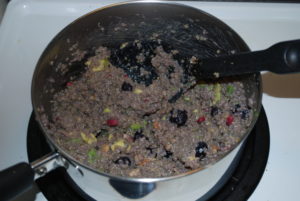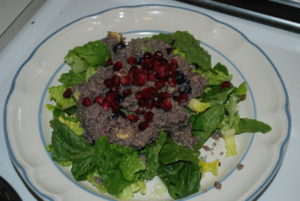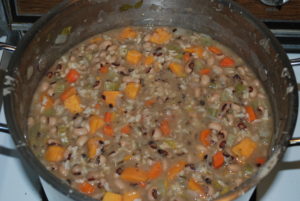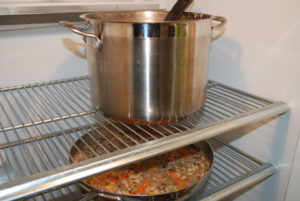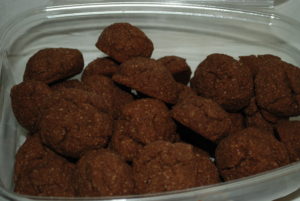For anyone following along with the pomegranate peel experiments (previous post)- update, I had a lot of pomegranate extract thawed at the same time and for a dietitian that means reheat to steaming to assure food safety. So it was an opportunity to experiment some more with trying to adjust the acidity again. When baking soda is added to a hot acidic liquid there is an obvious bubbling reaction and change in color of the liquid. I have pH strips to check acidity and did manage to adjust the acidity of the extract. The taste is still not great but chronic illness and mood issues are not great either. After three cups of experimental attempts my mood is awesome *(see additional note) and I have some recipe details:
6 cups of pomegranate extract (previous post)
2 Tablespoons Cardamom powdered spice
1 teaspoon Gumbo File powdered spice (Sassafras Leaves, powdered and used in Gumbo’s in Creole style cooking)
1 teaspoon Baking Powder
- Add the Cardamom and Gumbo File to the Pomegranate Extract and stir well to break apart any dry lumps of the powdered spices. The Gumbo File acts as an emulsifier and is a digestive aid and the Cardamom adds flavor, phytonutrients and would help alkalize the mixture in addition to the alkalizing power of the Baking Soda.
- Bring the mixture to a boil.
- Add the Baking Soda and stir. Remove the mixture from the heat and keep stirring. It will froth up and stirring helps keep it from frothing over the top of the pan. The color changes from pinkish to brown from the Cardamom spice.
- To drink as a beverage dilute with equal parts water to Pomegranate Extract.
This would be an acquired taste – aka “not good” until you get used to it, or not good at all but the mood and health benefits are worth for me at least. It is also a diuretic which means it is like beer or coffee in the way it increases kidney activity and urine production so it is best to have it earlier in the day followed by plenty of glasses of water early in the day so that you aren’t waking up in the middle of the night as much. Overly acidic, dehydrated body fluids can increase work for the kidneys and result in a frequent feeling of needing to go urgently but then not producing much quantity – drink plenty of water early in the day and produce plenty of dilute quantity early in the day and a diuretic can help cleanse toxins from the body instead of being a middle of the night problem.
Since pomegranate growing season is limited the powdered spice made from Sumac might be a health substitute. It has been shown to have a range of health benefits, and is also a diuretic. Its phytonutrients are similarly colored suggesting there might be some similar antioxidant content as well. The gallotannin group of phytonutrients are in common and would likely promote Nrf2. (More about Sumac in this post) (a series of posts on Nrf2)
To put a financial perspective on this – for my health needs the pomegranate extract or pomegranate seeds and cardamom powder and a few other good sources of phospholipids are adequate replacements for my medical marijuana which cost me around $1000-1200 per month. The medical effects are slightly different and not quite as good for pain killing properties but the negative psychological effects that can occur with withdrawal for some people are also not present.
To review – cannabinoids are a group of chemicals that are made within the cells of most species and are similar to the group of cannabinoids found in the cannabis plants commonly known as marijuana or hemp. Medical marijuana has a euphoria producing one known by the chemical initials THC while hemp has only non-euphoria producing cannabinoids. Both types can have medical or other basic health benefits. Cannabinoids are found throughout membranes and add to cell wall flexibility and help with messenger chemical type activities that can help reduce inflammation and fight infection. Some people such as myself can have genetic differences that make it impossible to make the chemicals internally as in average health. I have had minor health problems since infancy and having external dietary sources of phospholipids or cannabinoids helps my body and mood and immune system. More information about the topic is available in the post/article Is it Addiction or Starvation?
People with problems with binge eating disorders, alcohol abuse tendencies, meth or heroin/opioid abuse tendencies, or seem to have an excess use of marijuana, and nicotine to a lesser extent all may actually have underlying genetic differences that leave them in need of increased dietary sources of phospholipids/cannabinoids. The article Is It Addiction or Starvation? has some legal food sources in addition to pomegranate seeds and cardamom spice. It doesn’t mention the Middle Eastern spice Sumac but it might help also.
*Additional note – three cups was likely to large of a serving, an awesome mood for someone with unstable mood issues was too much of a good thing – Newton’s Law of Gravity may apply metaphorically, “What goes up must come down.” I had a worse mood problem later in the evening. Today (the next morning) I’ve enjoyed a few spoonfuls of the spicy, creamy slightly thickened mixture in my coffee and it is good to my “acquired taste.” The thing about having acquired an acquired taste for something is that you then want to acquire more – pun intended. The pomegranate season in Australia turns out to also be November to March so that isn’t much help. Processing pomegranate peel during the growing season would be necessary if I hope to continue to be able to acquire pomegranate extract all year long. It has medicinal benefits according to the research that is available, (see links in earlier posts on this site).
New Zealand isn’t ideal for pomegranate either as the summer length may be too short some years, however their harvest season is February-April: “Pomegranates grow best in areas with cold Winters and long hot, dry Summers.” (Pomegranate Wonderful)
Disclaimer: Opinions are my own and the information is provided for educational purposes within the guidelines of fair use. While I am a Registered Dietitian this information is not intended to provide individual health guidance. Please see a health professional for individual health care purposes.

